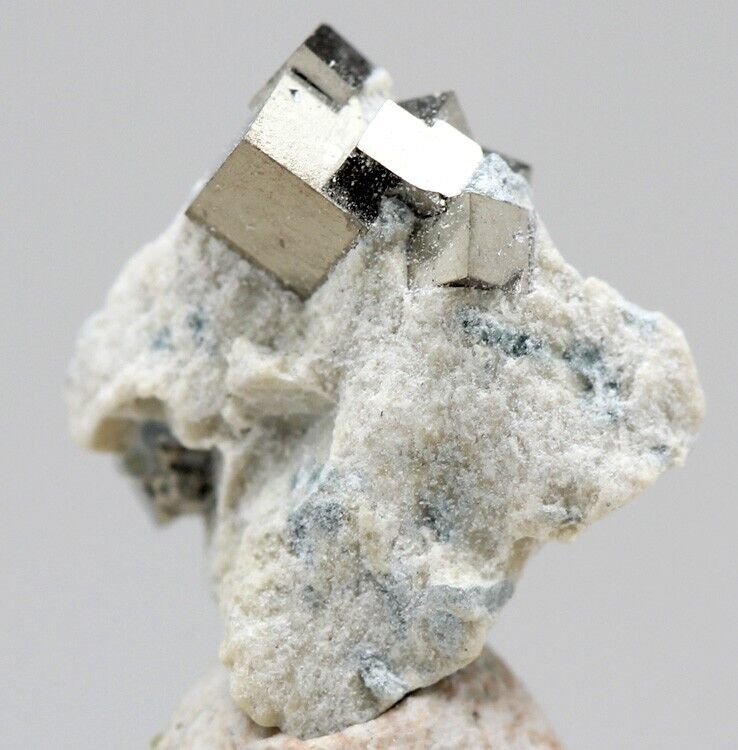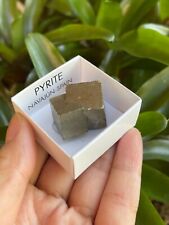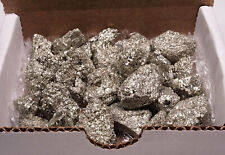PYRITE CUBE IN MATRIX Specimen Crystal Cluster Mineral SPAIN w/ ID card For Sale

When you click on links to various merchants on this site and make a purchase, this can result in this site earning a commission. Affiliate programs and affiliations include, but are not limited to, the eBay Partner Network.
PYRITE CUBE IN MATRIX Specimen Crystal Cluster Mineral SPAIN w/ ID card:
$5.99
This listing is for a really fascinating pyrite cube specimen in a display jar,including an info card about this mineral and the location this specimen came from.
This kit is great for avid mineral specimen collectors or beginners.
It would be a perfect gift set for getting someone interested in mineral collecting and science.
The 1 centimeter scale cube is for size comparison only. It is not included in the sale.
The photos are of several different specimens, but this listings is for one specimen with an info card.
The photos show multiple specimens to give a representation of the variety of shapes and colors in these specimens.I offer a shipping discount for customers who combine their payments for multiple purchases into one payment!
The discount is regular shipping price for the first item and just 50 cents for each additional item!
To be sure you get your shipping discount just make sure all the items you want to purchase are in your cart.
sales you win are added to your cart automatically.
For any "buy it now" items or second chance offers, be sure to click the "add to cart" button, NOT the "buy it now" button.
Onceall of your items are in your cart just pay for them from your cart andthe combined shipping discount should be applied automatically.I offer a money back guarantee on every item I sell.
If you are not 100% happy with your purchase just send me a message to let me know
and I will buy back the item for your full purchase price.Hi there. I am selling this really lovely pyrite cube mineral specimen. It is from Navajún, Spain. If you have any questions, do not hesitate to ask me. Have fun offerding, thanks so much for visiting my sale and have a great day!
The following is a wikipedia entry about pyrite:
This article is about iron pyrite. For other pyrite minerals, see Pyrite group.
Pyrite
Pyrite - Huanzala mine, Huallanca, Bolognesi, Ancash, Peru.jpg
Intergrowth of lustrous, cubic crystals of pyrite, with some surfaces showing characteristic striations, from Huanzala mine, Ancash, Peru. Specimen size: 7.0 × 5.0 × 2.5 cm
General
Category Sulfide mineral
Formula
(repeating unit) FeS2
IMA symbol Py[1]
Strunz classification 2.EB.05a
Dana classification 2.12.1.1
Crystal system Cubic
Crystal class Diploidal (m3)
H-M symbol: (2/m 3)
Space group Pa3
Unit cell a = 5.417 Å, Z = 4
Identification
Formula mass 119.98 g/mol
Color Pale brass-yellow reflective; tarnishes darker and iridescent
Crystal habit Cubic, faces may be striated, but also frequently octahedral and pyritohedral. Often inter-grown, massive, radiated, granular, globular, and stalactitic.
Twinning Penetration and contact twinning
Cleavage Indistinct on {001}; partings on {011} and {111}
Fracture Very uneven, sometimes conchoidal
Tenacity Brittle
Mohs scale hardness 6–6.5
Luster Metallic, glistening
Streak Greenish-black to brownish-black
Diaphaneity Opaque
Specific gravity 4.95–5.10
Density 4.8–5 g/cm3
Fusibility 2.5–3 to a magnetic globule
Solubility Insoluble in water
Other characteristics paramagnetic
References [2][3][4][5]
The mineral pyrite (/ˈpaɪraɪt/),[6] or iron pyrite, also known as fool's gold, is an iron sulfide with the chemical formula FeS2 (iron (II) disulfide). Pyrite is the most abundant sulfide cubic crystals on marl from Navajún, La Rioja, Spain (size: 95 by 78 millimetres [3.7 by 3.1 in], 512 grams [18.1 oz]; main crystal: 31 millimetres [1.2 in] on edge)
Pyrite's metallic luster and pale brass-yellow hue give it a superficial resemblance to gold, hence the well-known nickname of fool's gold. The color has also led to the nicknames brass, brazzle, and Brazil, primarily used to refer to pyrite found in coal.[7][8]
The name pyrite is derived from the Greek πυρίτης λίθος (pyritēs lithos), 'stone or mineral which strikes fire',[9] in turn from πῦρ (pyr), 'fire'.[10] In ancient Roman times, this name was applied to several types of stone that would create sparks when struck against steel; Pliny the Elder described one of them as being brassy, almost certainly a reference to what we now call pyrite.[11]
By Georgius Agricola's time, c. 1550, the term had become a generic term for all of the sulfide under normal and polarized light
Pyrite is usually found associated with other sulfides or oxides in quartz veins, sedimentary rock, and metamorphic rock, as well as in coal beds and as a replacement mineral in fossils, but has also been identified in the sclerites of scaly-foot gastropods.[13] Despite being nicknamed "fool's gold", pyrite is sometimes found in association with small quantities of gold. A substantial proportion of the gold is "invisible gold" incorporated into the pyrite (see Carlin-type gold deposit). It has been suggested that the presence of both gold and arsenic is a case of coupled substitution but as of 1997 the chemical state of the gold remained abandoned pyrite mine near Pernek in Slovakia
Pyrite enjoyed brief popularity in the 16th and 17th centuries as a source of ignition in early firearms, most notably the wheellock, where a sample of pyrite was placed against a circular file to strike the sparks needed to fire the gun.[15]
Pyrite is used with flintstone and a form of tinder made of stringybark by the Kaurna people, people of South Australia, as a traditional method of starting fires.[16]
Pyrite has been used since classical times to manufacture copperas (ferrous sulfate). Iron pyrite was heaped up and allowed to weather (an example of an early form of heap leaching). The acidic runoff from the heap was then boiled with iron to produce iron sulfate. In the 15th century, new methods of such leaching began to replace the burning of sulfur as a source of sulfuric acid. By the 19th century, it had become the dominant method.[17]
Pyrite remains in commercial use for the production of sulfur dioxide, for use in such applications as the paper industry, and in the manufacture of sulfuric acid. Thermal decomposition of pyrite into FeS (iron(II) sulfide) and elemental sulfur starts at 540 °C (1,004 °F); at around 700 °C (1,292 °F), pS2 is about 1 atm.[18]
A newer commercial use for pyrite is as the cathode material in Energizer brand non-rechargeable lithium metal batteries.[19]
Pyrite is a semiconductor material with a band gap of 0.95 eV.[20] Pure pyrite is naturally n-type, in both crystal and thin-film forms, potentially due to sulfur vacancies in the pyrite crystal structure acting as n-dopants.[21]
During the early years of the 20th century, pyrite was used as a mineral detector in radio receivers, and is still used by crystal radio hobbyists. Until the vacuum tube matured, the crystal detector was the most sensitive and dependable detector available—with considerable variation between mineral types and even individual samples within a particular type of mineral. Pyrite detectors occupied a midway point between galena detectors and the more mechanically complicated perikon mineral pairs. Pyrite detectors can be as sensitive as a modern 1N34A germanium diode has been proposed as an abundant, non-toxic, inexpensive material in low-cost photovoltaic solar panels.[24] Synthetic iron sulfide was used with copper sulfide to create the photovoltaic material.[25] More recent efforts are working toward thin-film solar cells made entirely of pyrite.[21]
Pyrite is used to make marcasite jewelry. Marcasite jewelry, made from small faceted pieces of pyrite, often set in silver, was known since ancient times and was popular in the Victorian era.[26] At the time when the term became common in jewelry making, "marcasite" referred to all iron sulfides including pyrite, and not to the orthorhombic FeS2 mineral marcasite which is lighter in color, brittle and chemically unstable, and thus not suitable for jewelry making. Marcasite jewelry does not actually contain the mineral marcasite. The specimens of pyrite, when it appears as good quality crystals, are used in decoration. They are also very popular in mineral collecting. Among the sites that provide the best specimens are Soria and La Rioja provinces (Spain).[27]
In value terms, China ($47 million) constitutes the largest market for imported unroasted iron pyrites worldwide, making up 65% of global imports. China is also the fastest growing in terms of the unroasted iron pyrites imports, with a CAGR of +27.8% from 2007 to July 2020 scientists reported that they have observed a voltage-induced transformation of normally diamagnetic pyrite into a ferromagnetic material, which may lead to applications in devices such as solar cells or magnetic data at Trinity College Dublin, Ireland have demonstrated that FeS2 can be exfoliated into few-layers just like other two-dimensional layered materials such as graphene by a simple liquid-phase exfoliation route. This is the first study to demonstrate the production of non-layered 2D-platelets from 3D bulk FeS2. Furthermore, they have used these 2D-platelets with 20% single walled carbon-nanotube as an anode material in lithium-ion batteries, reaching a capacity of 1000 mAh/g close to the theoretical capacity of FeS2.[31]
In 2021, a natural pyrite stone has been crushed and pre-treated followed by liquid-phase exfoliation into two-dimensional nanosheets, which has shown capacities of 1200 mAh/g as an anode in lithium-ion batteries.[32]
Formal oxidation states for pyrite, marcasite, molybdenite and arsenopyrite
From the perspective of classical inorganic chemistry, which assigns formal oxidation states to each atom, pyrite and marcasite are probably best described as Fe2+[S2]2−. This formalism recognizes that the sulfur atoms in pyrite occur in pairs with clear S–S bonds. These persulfide [–S–S–] units can be viewed as derived from hydrogen disulfide, H2S2. Thus pyrite would be more descriptively called iron persulfide, not iron disulfide. In contrast, molybdenite, MoS2, features isolated sulfide S2− centers and the oxidation state of molybdenum is Mo4+. The mineral arsenopyrite has the formula FeAsS. Whereas pyrite has [S2]2– units, arsenopyrite has [AsS]3– units, formally derived from deprotonation of arsenothiol (H2AsSH). Analysis of classical oxidation states would recommend the description of arsenopyrite as structure of pyrite. In the center of the cell a S22− pair is seen in yellow
Iron-pyrite FeS2 represents the prototype compound of the crystallographic pyrite structure. The structure is simple cubic and was among the first crystal structures solved by X-ray diffraction.[34] It belongs to the crystallographic space group Pa3 and is denoted by the Strukturbericht notation C2. Under thermodynamic standard conditions the lattice constant
�
a of stoichiometric iron pyrite FeS2 amounts to 541.87 pm.[35] The unit cell is composed of a Fe face-centered cubic sublattice into which the S
2 ions are embedded. (Note though that the iron atoms in the faces are not equivalent by translation alone to the iron atoms at the corners.) The pyrite structure is also seen in other MX2 compounds of transition metals M and chalcogens X = O, S, Se and Te. Certain dipnictides with X standing for P, As and Sb etc. are also known to adopt the pyrite structure.[36]
The Fe atoms are bonded to six S atoms, giving a distorted octahedron. The material is a semiconductor. The Fe ions is usually considered to be low spin divalent state (as shown by Mössbauer spectroscopy as well as XPS). The material as a whole behaves as a Van Vleck paramagnet, despite its low-spin divalency.[37]
The sulfur centers occur in pairs, described as S22−.[38] Reduction of pyrite with potassium gives potassium dithioferrate, KFeS2. This material features ferric ions and isolated sulfide (S2-) centers.
The S atoms are tetrahedral, being bonded to three Fe centers and one other S atom. The site symmetry at Fe and S positions is accounted for by point symmetry groups C3i and C3, respectively. The missing center of inversion at S lattice sites has important consequences for the crystallographic and physical properties of iron pyrite. These consequences derive from the crystal electric field active at the sulfur lattice site, which causes a polarisation of S ions in the pyrite lattice.[39] The polarisation can be calculated on the basis of higher-order Madelung constants and has to be included in the calculation of the lattice energy by using a generalised Born–Haber cycle. This reflects the fact that the covalent bond in the sulfur pair is inadequately accounted for by a strictly ionic has a related structure with heteroatomic As–S pairs rather than S-S pairs. Marcasite also possesses homoatomic anion pairs, but the arrangement of the metal and diatomic anions differ from that of pyrite. Despite its name, chalcopyrite (CuFeS
2) does not contain dianion pairs, but single S2− sulfide anions.
Crystal crystals from Italy
Pyrite usually forms cuboid crystals, sometimes forming in close association to form raspberry-shaped masses called framboids. However, under certain circumstances, it can form anastomosing filaments or T-shaped crystals.[41] Pyrite can also form shapes almost the same as a regular dodecahedron, known as pyritohedra, and this suggests an explanation for the artificial geometrical models found in Europe as early as the 5th century BC.[42][clarification (CoS2), vaesite (NiS2) and hauerite (MnS2), as well as sperrylite (PtAs2) are similar in their structure and belong also to the pyrite group.
Bravoite is a nickel-cobalt bearing variety of pyrite, with > 50% substitution of Ni2+ for Fe2+ within pyrite. Bravoite is not a formally recognised mineral, and is named after the Peruvian scientist Jose J. Bravo similar minerals
Pyrite is distinguishable from native gold by its hardness, brittleness and crystal form. Pyrite fractures are very uneven, sometimes conchoidal because it does not cleave along a preferential plane. Native gold nuggets, or glitters, do not break but deform in a ductile way. Pyrite is brittle, gold is malleable.
Natural gold tends to be anhedral (irregularly shaped without well defined faces), whereas pyrite comes as either cubes or multifaceted crystals with well developed and sharp faces easy to recognise. Well crystallised pyrite crystals are euhedral (i.e., with nice faces). Pyrite can often be distinguished by the striations which, in many cases, can be seen on its surface. Chalcopyrite (CuFeS2) is brighter yellow with a greenish hue when wet and is softer (3.5–4 on Mohs' scale).[44] Arsenopyrite (FeAsS) is silver white and does not become more yellow when wet.

Related Items:
Grade A++ Spanish Pyrite Cube, Fools Gold Rock Reiki Crystal, Wholesale Bulk Lot
$219.95
PYRITE CUBE IN MATRIX Specimen Crystal Cluster Mineral SPAIN w/ ID card
$5.99
Iron Pyrite Collection Natural Chispa Crystals Fools Gold
$12.71



